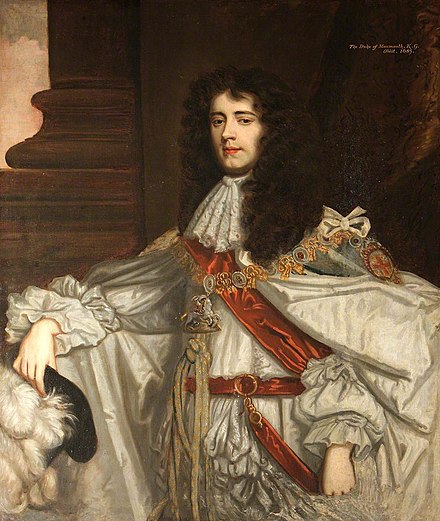The Duke of Monmouth
Lucy Walter, a single Welsh woman of gentle birth, gave birth to a son named James on April 9th 1649 in The Hague. The father was acknowledged to be Charles Stuart, son and heir to King Charles I of Scotland and England who had been executed in Whitehall, London, the previous January. The young prince/king was aged 18 when this, his eldest known child, was born.
Charles was already embarked on his career as a serial philanderer and had little contact with Lucy after the birth of their son. She and her son returned to England in 1656. Clearly the liaison with Charles, now claiming to be King Charles II, was known to Cromwell’s people; mother and child were briefly held in the Tower of London, before being released as they were not considered a threat to the Commonwealth government. Lucy was then deported to Brussels in the Spanish Netherlands. She was penniless after a series of liaisons with other men, and began to make claims that she and the young King Charles were secretly married.
In 1658, agents of Charles kidnapped the young James and took him to Paris, where Charles was living as a guest of the French king, Louis XIV. He was put in the care of one of Charles’ exiled courtiers, Baron Crofts of Saxham. Lucy returned to Paris but was unable to find her son. She had no money, and she was riddled with disease. Lucy died in the first week of December 1658 aged about 28.
After the Restoration of the monarchy in 1660, her son was recalled to England by his father Charles II, who created him Duke of Monmouth, Earl of Doncaster, Baron Scott of Tindale and made him a Knight of the Garter. In 1663, soon after his fourteenth birthday, Monmouth was married to the Scottish heiress Anne, Countess of Buccleuch, aged 12; they were created Duke and Duchess of Buccleuch, and he took her surname of Scott. Clearly James Monmouth was held in high esteem by the king; he was made captain of the king’s guard in 1668 and admitted to the Privy Council in 1670.
Although he was brought up a Protestant, Monmouth was sent to serve as part of the French army during the Third Anglo-Dutch War which broke out in 1672. He led a brigade of English and Scottish troops and gained a growing reputation as a soldier during the war against his fellow-religionists in the Netherlands. He became Captain-General of all the armed forces in England in 1678 and, in June 1679, he scored a victory over Scottish Covenanter rebels, who had risen in rebellion against the king’s persecution of nonconformists.
That year, allegations made by a strange character called Titus Oates created hysteria in England concerning a supposed ‘Popish Plot’ to murder the king and restore the Roman Catholic faith as the state religion of England. Charles II himself examined Oates and, knowing a liar when he saw one, found his story unconvincing. However, several Catholics were gruesomely executed, including the Irish archbishop of Armagh, and a fierce campaign was launched against James, Duke of York, brother of Charles II and heir to the throne, who was a declared Catholic. The king suspected Monmouth was involved in the campaign, and sent him into exile.
Monmouth soon returned and, seeking support for his own frail claim to the throne, did nothing to dampen plans by the new Whig group in Parliament to prevent York acceding to the crown. Eventually a Whig conspiracy against Charles II and his brother James, known as the Rye House Plot, was revealed. Monmouth was pardoned for his part in the enterprise, but he was banished from court and took refuge in the Netherlands early in 1684.
Charles II died early in 1685 and his brother was crowned James II and VII, King of England and Scotland. Monmouth was convinced he could raise enough support to overcome the Catholic king. He landed at Lyme Regis in Dorset, with only 82 followers in June. He soon raised over 4,000 men among the farmers, artisans and some local militia in the West Country, but he was unable to rally the gentry and nobility to his cause.
On July 6 his amateur army was totally defeated at Sedgemoor by a royalist force which included John Churchill (the future Duke of Marlborough) who commanded the foot soldiers. At the ‘Bloody Assizes’, held at towns and cities throughout the West Country, Lord Chief Justice Jeffries sentenced some three hundred Monmouth supporters to death and deported hundreds more to miserable servitude and death in the Americas. The Duke of Monmouth was soon captured and suffered a horrible death on 15th July at the hands of the incompetent executioner, Jack Ketch, who only severed his head from his body with a knife after several failed attempts with the axe.
